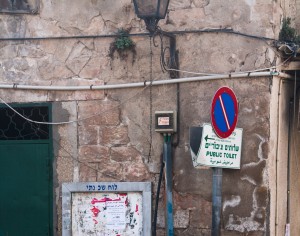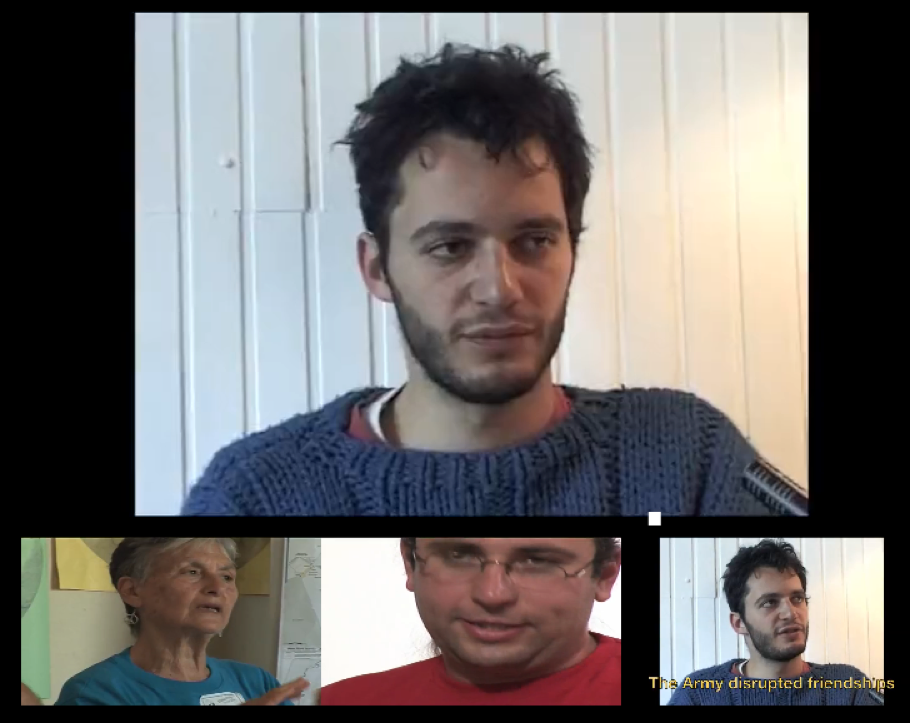The Only Democracy? » On The Ground Reports » Welcome to the Zoo
Welcome to the Zoo
By Audrey Farber, crossposted at Mondoweiss.net
My neighborhood doesn’t have street signs. And when it does, they don’t refer to names of streets anyone is familiar with. House numbers, too, are scarce. I didn’t know my own street address until yesterday – four and a half months after my arrival. My neighborhood doesn’t have the big plastic-and-glass street-side recycling cages that are conveniently placed around the rest of the city. Its streets are narrow and winding, and children on bikes navigate the obstacle course created by their siblings and cousins and neighbors playing soccer between doorway goal posts. There is one bus stop, few taxis, and I’d be surprised if there were street lights.
But it does have public restrooms (see photo), and signs directing adventurous tourists towards them in no less than three languages. It’s featured in all the guidebooks as the neighborhood in which the best falafel can be found, down a side alley in an unassuming hole in the wall. Although if you ask me, I think it’s on a pretty average street in a pretty average storefront. I guess it depends on your perspective.
My neighborhood is the location of the “Middle Eastern bazaar” and outdoor market, obligatory shawarma “stalls” and baklawa shops, and deliberately-placed public art pieces by, for the most part, Jewish artists depicting various themes of cooperation and coexistence. But no Jewish Israelis live in my neighborhood – indeed, most Jewish Israelis I know are shocked that I live here. “Is it safe?”
My neighborhood is condescendingly? patronizingly? affectionately? referred to in Lonely Planet as “Haifa’s grizzled old Christian-Arab quarter” and all signs (literally) point to it being maintained as such to lend the city an air of authentic Middle Eastern-ness, as long as it stays within its confines and preset boundaries. This is where the tourists go to get a taste of the old-school Middle East, a little Arab flavor in a Jewish-only melting pot. It is smack dab in the middle of one of Israel’s few examples of pseudo-co-existence; one of the only places the Israeli government could stomach such a blatant display of the persistent existence of non-Jewishness. Throwing a tired old gnawed-out bone to all the civil rights defenders out there: look at our diversity!
Come visit the Jewish state and while you’re at it, look at these primitive Arabs in their small, confined space – just like they lived before we swooped in and civilized this desert wasteland with milk and honey and fruits and wine and all that jazz. And guns. (Never mind the decades of British rule and before that centuries of Ottoman administration that preceded us.) We are preserving their heritage for them … by denying them opportunities to advance and succeed and confining them to their narrow, scuzzy alleyways, selling eggplants at a discounted rate and smiling and nodding ahlan wa sahlan for tour buses full of middle aged Americans. (You know they aren’t birthright kids because birthright kids aren’t allowed near Arabs: danger, danger!) Of course, not one of Haifa’s several museums – dedicated to everything from Japanese Art to Clandestine Immigration to the Israeli Oil Industry – represents Palestinian culture, art, or history.
This is a community on display. It is “the famous Wadi Nisnas whose charming alleyways have turned it into a tourist spot.” It’s the only remaining part of its Middle Eastern-ness that Israel can exploit without fear of criticism or retaliation, because the Orientalist inside all of us doesn’t see the ghettoization of the Arab as something that needs to be rectified. This community is stuck inside its bars, fed scraps of economic opportunity to pacify it but never allowed to forget that it is not equal in the eyes of the state. Capital S State.
Overshadowed by the imposing hotel towers at the top of the hill (read: affluent Jewish neighborhoods) and bound at its base by the militarized industrial port, it’s a small haven of an increasingly smothered culture, a segment of society whose rights are diminished by the day. And the best part is, living here makes you feel like you’re a part of the zoo, too. On display with the pita bread and fresh-caught fish, for the enjoyment of tourists everywhere. And they can even find the restrooms.
Filed under: On The Ground Reports · Tags: anti-Arab racism, Haifa, neighborhood, street









 “You have a choice! Israeli Anti-Militarists Speak”
“You have a choice! Israeli Anti-Militarists Speak”